Analyzing Intel Core M Performance: How 5Y10 can beat 5Y71 & the OEMs' Dilemma
by Brett Howse & Ian Cutress on April 8, 2015 8:00 AM ESTCinebench R15 Single-Threaded Results
Cinebench will run the CPU up to 100% load for the duration of the test. As this is the single-threaded run, only one core will be active, which should in theory provide more headroom for that one core than when all cores (physical and virtual) are loaded. There is no burst workload here at all, and sustained single-threaded performance is the key for this test.
The Core i5 does exactly what would be expected for this benchmark. With just a single core loaded, the cooling system has no issues keeping the CPU from throttling. It maintains an extremely consistent CPU frequency during the run. This cannot be said of the two Core M-5Y71 devices though. The Dell Venue 11 Pro starts off with quite a high frequency, but as the temperature increases, the CPU drops in frequency to keep below the threshold of 90°C set on the SoC. At any opportunity, it increases its CPU frequency to try to increase performance, but generally that does not last for very long, and it ends up falling back down. The Yoga 3 Pro on the other hand, has a much lower allowed SoC temperature, with Lenovo locking in on 65°C as their maximum target temperature. This keeps the frequency down.
The ASUS Zenbook has an entirely flat CPU line though. The excellent heat dissipation of the chassis allows it to run for the duration of the benchmark with no throttling at all. It has to be noted though that the maximum CPU frequency is a quite a bit lower than the 5Y71 devices, topping out at 2.0 GHz versus 2.9 GHz for 5Y71. It would be very interesting to see how the UX305 would do with the faster CPU inside, and if it would run into throttling issues as well.

Looking at the average CPU frequency over the run shows that the i5 clearly has the most headroom, which is not surprising. Averages are only part of the story though, with both of the 5Y71 devices being able to jump past the 5Y10's frequency several times during the test.
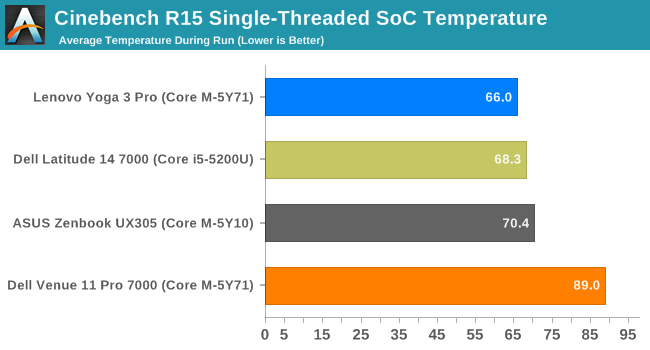
Looking at temperatures, it's interesting to note that the Dell Venue 11 Pro has the top-tier Core M-5Y71, but it puts that processor in what is the smallest chassis and with a plastic exterior. Consequently it quickly loads up to its maximum temperature and stays there for the duration. The rest of the devices stay much cooler with just a single core loaded.
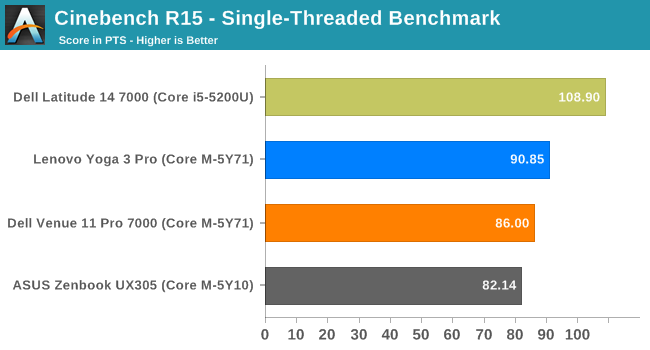
Here we have the actual benchmark results. On single-threaded workloads, the 5Y71 can and does outperform 5Y10. Despite the average CPU frequencies being lower on both 5Y71 devices, they had enough headroom when necessary to jump past the very consistent 5Y10. None of them can match the Core i5 in this test. It is actually very interesting that the highest scoring Core M in this test has the lowest average CPU frequency.


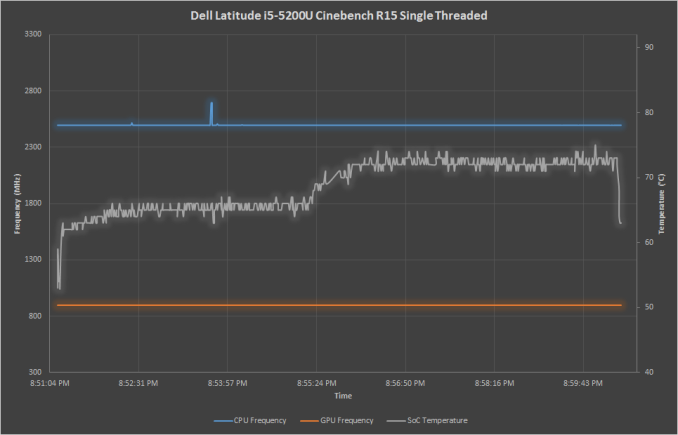
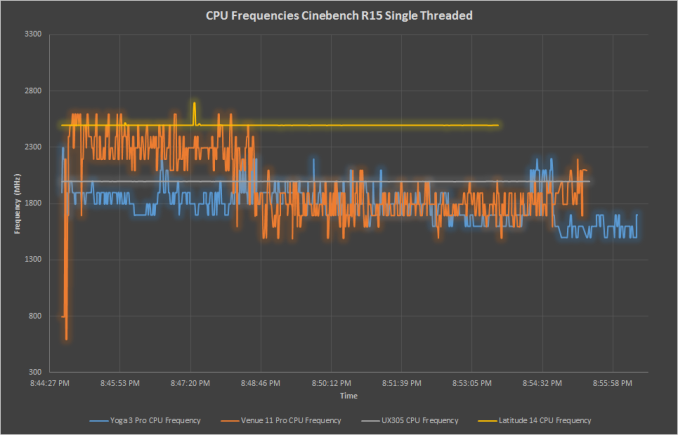
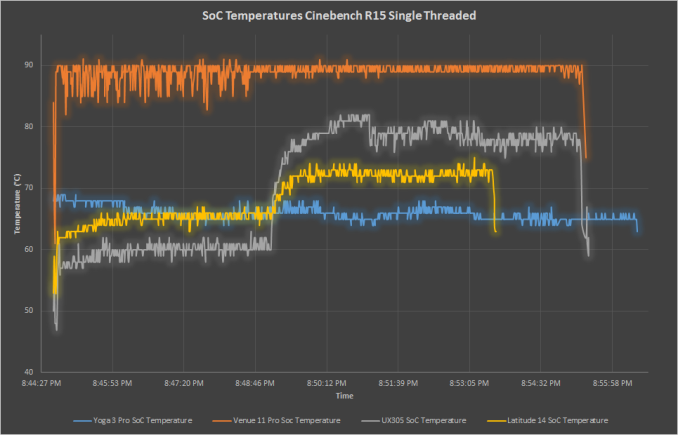








110 Comments
View All Comments
xilience - Wednesday, April 8, 2015 - link
Minor issue with one of the graphs. PCMark8 Home graph, the temperature scales are different for each device, whereas they look to be the same for all other tests. The numbers are correct, but when quickly comparing graphs it can be confusing to read. THANKS for this great article, it gives a lot of insight into mobile hardware design.digiguy - Wednesday, April 8, 2015 - link
Very interesting article. Core M makes sense (contrary to what some people say in the comments) for those that have the money and want a totally silent device.Having said that, some ultrabooks and core tablets (like my 35W TDP Asus ultrabook or my surface pro 3 i3) are extremely silent, with the fan kicking in only while gaming, which in my opinion is a small concession in exchange for sustained performance (zero throttling in either of the 2 devices).
Also the race to the thinnest device is probably questionable, especially for laptops. Making a smaller device with a bigger screen like Dell did is a great idea, making it thinner and thinner doesn't add much and subtracts performance or adds heat.
What a pity you didn't add the new Macbook to the comparison (probably not available yet). Hope you will do an updated version with it. It will also allow to see how 5y71 performs in a laptop, rather than in a convertible/tablet.
TEAMSWITCHER - Wednesday, April 8, 2015 - link
The problem with just making devices thicker and adding fans is that it compromises portability for only a little in extra performance.For nearly a decade, I carried around a 15" PowerBook or MacBook Pro. Good machines but only mid-range graphic performance. Recently, I slimmed down to an 11" MacBook Air, and I will never...ever...go back to lugging around a larger device.
I also have a desktop Windows Workstation for performance oriented work. It's much faster than any laptop you can buy. Using Drop Box and One Drive I keep files synced between the two machines, and can just hop-up from my Workstation, grab my Mac Book, and hit the door.
Thankfully, my computer budget is large enough to afford a Workstation and a Mac Book - it's actually a necessity for cross-platform developers. I get extreme performance from my workstation and extreme portability from my Mac Book. I don't have to live with compromises, I just have to switch devices.
Refuge - Wednesday, April 8, 2015 - link
I'm all for small form factors and portability, I notice the difference between my 15 inch laptop and my girlfriends 10 inch convertable. It is substantial, but I don't feel that going thinner is the way anymore.The increase in portability I feel personally is purely from the decrease in screen size which naturally lowers the dimensions and weight of the device considerably, but some of these are getting so thin that they are actually uncomfortable, I don't want to hold a blade, or a brick, give me a thing (but not a blade like thin) laptop with a 11 inch screen for on the go work, make it cool, quiet, and perform, and make it like an inch thick, then knock it from $1,000 to $500. I'll buy it everytime.
I feel the same way about phones, I don't want my next one to be thinner, or have a bigger screen.
5 inches fits my hand perfectly, I don't work or game on it. I use it to pass time reading Anandtech or communicating with the world.
I game at home on my SFF that I can easily take to a lan party, or I work on my portable but not paper thin laptop.
I'm happy in all regards honestly. But I suppose this just comes down to personal preference much like how nice peripherals are comes down to taste in the end barring any insufferable design choices.
wallysb01 - Thursday, April 9, 2015 - link
"5 inches fits my hand perfectly"That's what she said.
digiguy - Wednesday, April 8, 2015 - link
"The problem with just making devices thicker and adding fans is that it compromises portability for only a little in extra performance."I think it's actually the contrary, if we talk about laptops/ultrabooks. There can be a big increase in performance for very little increase in thinkness and noise. My ultrabook has a 35w mobile second generation i7 that still performs better than any 4th gen i7 ULV CPUs, let alone Core M... And still it's thin, light and with 8 hours battery life. It is so silent that the fan won't kick in even when I do an OCR of a 10 page file...
For tablets it's different, but still, my SP3 (i3) is thin and has a fan, that never kicks in... Only while gaming, and I am actually happy it does, cause this way there is no throttling.... I would want it to be fanless.... (as I wouldn't like the fan to kick in more often like in the i5 and especially i7 models).
digiguy - Thursday, April 9, 2015 - link
Sorry in the last sentence I meant "I wouldN'T want it to be fanless"Krysto - Wednesday, April 8, 2015 - link
> Atom sits at the lower price band ($50-$100 per chip), typically in a dual or quad core arrangement without hyperthreading and uses ‘modules’ of two discrete cores sharing an L2 cache.More like $107-$161 going by your previous "Braswell" article.
What I'd like to see is how does the $281 Core-M compare to the ~$100 Haswell Celeron from the previous generation in terms of performance.
smilingcrow - Wednesday, April 8, 2015 - link
Brawell is a different market sector though so pricing may not be comparable.kyuu - Wednesday, April 8, 2015 - link
He was referring to mobile atoms (the ones that compare directly to Core M). Braswell is a different market segment, as smilingcrow said.